Catalog # |
Size |
Price |
|
|---|---|---|---|
| WBK-010-08 | 1 kit | $777 |
| View/Download (PDF) - for reference only |
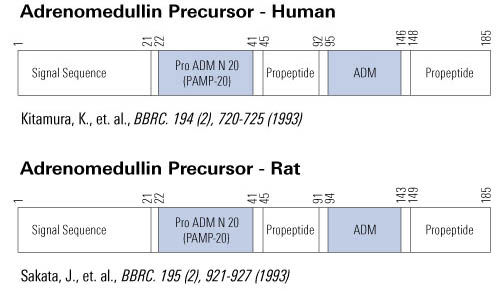 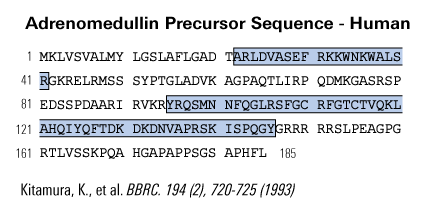 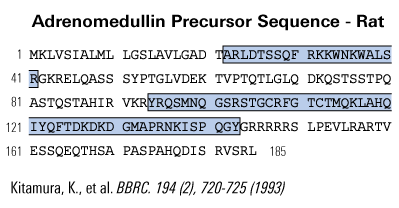 |
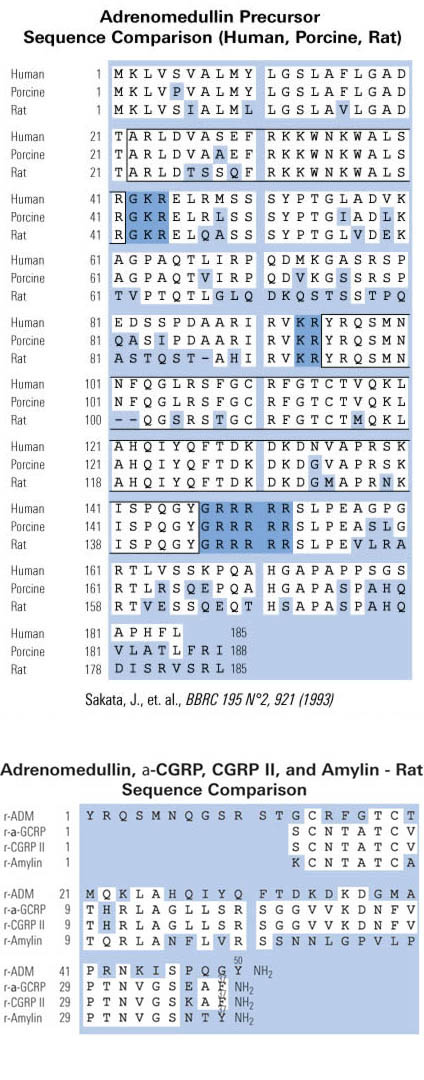 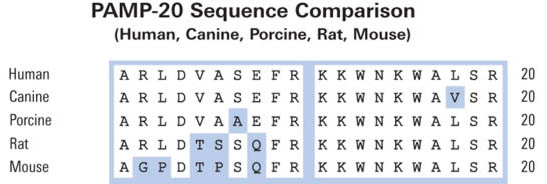 |
AIMS: Adrenomedullin (ADM) is a vasodilatory peptide. Its plasma levels or its precursors have not been evaluated in large populations of patients with chronic heart failure (CHF). We sought to explore mid-regional proADM (MR-proADM). METHODS AND RESULTS: We assessed MR-proADM in 501 CHF patients [age 63 +/- 11 years, New York Heart Association (NYHA) class I/II/III/IV 9/44/39/8%, median N-terminal pro-B-type natriuretic peptide (NT-proBNP) 878 pg/mL (interquartile range-IQR 348-2480 pg/mL), median left ventricular ejection fraction (LVEF) 31% (IQR 25-37%)]. Mid-regional pro-adrenomedullin levels (median 0.64 nmol/L, IQR 0.49-0.87 nmol/L) increased with NYHA class (P < 0.0001). During 1-year follow-up, 70 patients (14%) died. Increasing MR-proADM was a predictor of poor survival at 12 months (hazard ratio 1.82, 95% confidence interval 1.24-2.66, P = 0.002) after multivariable adjustment. In receiver-operating characteristic curve analysis of 12-month survival, the area under the curve for MR-proADM and NT-proBNP was similar (P = 0.3). Comparison of Cox proportional hazard models using the likelihood ratio chi(2) statistic showed that both NT-proBNP and MR-proADM added prognostic value to a base model of LVEF, age, creatinine, and NYHA class. Adding MR-proADM to the base model had stronger prognostic power than adding NT-proBNP (both P < 0.01). CONCLUSION: Mid-regional pro-adrenomedullin is an independent predictor of mortality in CHF patients, which adds prognostic information to NT-proBNP.
Von haehling S, Filippatos GS, Papassotiriou J, et al. Mid-regional pro-adrenomedullin as a novel predictor of mortality in patients with chronic heart failure. Eur J Heart Fail. 2010;12(5):484-91.
Adrenomedullin (AM) is a 52-amino acid peptide with a pluripotentialactivity. AM is expressed in many tissues throughout the body, and plays acritical role in several diseases such as cancer, diabetes, cardiovascular and renal disorders, among others. While AM is a protective agent against cardiovascular disorders, it behaves as a stimulating factor in other pathologies such as cancer and diabetes. Therefore, AM is a new and promising target for the development of molecules which, through their ability to regulate AM levels, could be used in the treatment of these pathologies.
Julián M, Cacho M, García MA, et al. Adrenomedullin: a new target for the design of small molecule modulators with promising pharmacological activities. Eur J Med Chem. 2005;40(8):737-50.
Adrenomedullin (AM), an ubiquitous regulatory peptide with different actions, is known to be elevated in different clinical situations, including diabetes mellitus (DM), but its potential role in the pathogenesis of diabetic vascular complications is not clear. In the present study, we examined plasma total AM levels, and their association with different markers of endothelial dysfunction and with other established risk factors for cardiovascular diseases, in patients with Type 1 DM. We studied a total of 155 patients, 117 patients without any kind of vascular complications, 24 patients with retinopathy only, and 14 patients with retinopathy and microalbuminuria but normal renal function. None of them had clinical evidence of atherosclerotic disease. Compared with the control group (64 healthy participants), patients had raised fibrinogen, soluble E-selectin ((s)E-selectin), vascular cellular adhesion molecule (VCAM), angiotensin converting enzyme (ACE), and von Willebrand factor (vWf) (P<.001 in all cases), but plasma total AM, endothelin (ET), sialic acid, and homocysteine were not raised. In the diabetic group, AM levels correlated significantly with sialic acid (r=.16; P<.05), but a more significant correlation was found with fibrinogen (r=.30; P<.001). No correlation was found with the other parameters studied. In summary, plasma total AM levels seem to correlate with inflammatory markers but not with endothelial dysfunction markers in Type 1 diabetic patients without atherosclerotic disease.
García-unzueta MT, Berrazueta JR, Pesquera C, et al. Levels of plasma total adrenomedullin are related with two acute phase inflammatory reactants (fibrinogen and sialic acid) but not with markers of endothelial dysfunction in Type 1 diabetes Adrenomedullin and vascular risk factors in Type 1 DM. J Diabetes Complicat. 2005;19(3):147-54.
Diabetes mellitus is one of the most common chronic diseases affecting millions of people worldwide. Cardiovascular complication including myocardial infarction is one of the major causes of death in diabetic patients. Diabetes mellitus induces abnormal pathological findings including cell hypertrophy, neuropathy, interstitial fibrosis, myocytolysis and apoptosis and lipid deposits in the heart. In addition, the cytoplasmic organelles of cardiomyocytes including the plasma membrane, mitochondrion and sarcoplasmic reticulum are also impaired in both type I and type II diabetes. Hyperglycaemia is a major aetiological factor in the development of diabetic cardiomyopathy in patients suffering from diabetes. Hyperglycaemia promotes the production of reactive oxygen (ROS) and nitrogen species (RNS). The release of ROS and RNS induces oxidative stress leading to abnormal gene expression, faulty signal transduction and apoptosis of cardiomyocytes. Hyperglycaemia also induces apoptosis by p53 and the activation of the cytochrome c-activated caspase-3 pathway. Stimulation of connective tissue growth factor and the formation of advanced glycation end products in extracellular matrix proteins induces collagen cross-linking and contribute to the fibrosis observed in the interstitium of the heart of diabetic subjects. In terms of signal transduction, defects in intracellular Ca2+ signalling due to alteration of expression and function of proteins that regulate intracellular Ca2+ also occur in diabetes. All of these abnormalities result in gross dysfunction of the heart. Beta-adrenoreceptor antagonists, ACE inhibitors, endothelin-receptor antagonist (Bonestan), adrenomedullin, hormones (insulin, IGF-1) and antioxidants (magniferin, metallothionein, vitamins C and E) reduce interstitial fibrosis and improve cardiac function in diabetic cardiomyopathy.
Adeghate E. Molecular and cellular basis of the aetiology and management of diabetic cardiomyopathy: a short review. Mol Cell Biochem. 2004;261(1-2):187-91.
To investigate the pathophysiological role of two forms of adrenomedullin (AM), a mature AM (AM-m) and a glycine-extended AM (AM-Gly), in congenital heart disease, we measured plasma levels of AM in patients with cyanotic heart disease, high pulmonary blood flow without pulmonary hypertension (PH), high pulmonary blood flow with PH, Fontan procedure, intracardiac repair without complication, and intracardiac repair with PH and control subjects. Plasma AM-m and AM-Gly were increased only for cyanotic heart disease (2.5 +/- 1.3 pmol/L, p < 0.001; 13.1 +/- 6.2 pmol/L, p < 0.05) and intracardiac repair with PH (2.3 +/- 1.5 pmol/L, p < 0.01; 13.0 +/- 7.0 pmol/L, p < 0.05) compared with control (1.0 +/- 1.4 and 8.6 +/- 1.3 pmol/L, respectively). They were similarly correlated with mean systemic arterial pressure (r = -0.40 and -0.37 respectively; p < 0.001), mixed venous oxygen saturation (r = -0.60 and -0.50; p < 0.0001), systemic arterial oxygen saturation (SA(sat)) (r = -0.56 and -0.46; p < 0.0001), and pulmonary arterial resistance (Rp) (r = 0.41 and 0.38; p < 0.005). Multiple regression analysis revealed that SA(sat) and Rp were independently correlated with AM. Interestingly, the venous AM-m level was significantly higher than the arterial AM-m, suggesting that the mature form is extracted in pulmonary circulation, whereas there were no venoarterial differences in AM-Gly. These results suggest that plasma AM-m and AM-Gly are similarly regulated and the main clearance site of AM-m is the lung in patients with congenital heart disease.
Watanabe K, Nishikimi T, Takamuro M, et al. Two molecular forms of adrenomedullin in congenital heart disease. Pediatr Cardiol. 2003;24(6):559-65.
Both plasma levels of 8-epi-PGF2 and AM were significantly increased in hypertensive patients with type 2 diabetes compared with normal subjects (8-epi-PGF2 48.6 ± 8.6 vs. 11.9 ± 1.3 pg/ml, P < 0.05; AM 14.8 ± 0.7 vs. 12.4 ± 0.2 fmol/ml, P < 0.02). The plasma levels of 8-epi-PGF2 were proportionally correlated with AM (r = 0.696, P < 0.01) in only hypertensive patients with type 2 diabetes. Significant positive correlations were observed between plasma levels of 8-epi-PGF2 (r = 0.540, P < 0.05) or AM (r = 0.875, P < 0.001) and systolic blood pressure in patients with type 2 diabetes. In conclusion, there was a significant positive correlation between increased oxidative stress and elevated plasma levels of AM in hypertensive patients with type 2 diabetes. Enhanced oxidative stress may regulate the plasma levels of AM in hypertensive patients with type 2 diabetes.
Katsuki A, Sumida Y, Urakawa H, et al. Increased oxidative stress is associated with elevated plasma levels of adrenomedullin in hypertensive patients with type 2 diabetes. Diabetes Care. 2003;26(5):1642-3.
Experimental studies have demonstrated that adrenomedullin (AM) has a positive inotropic action and exerts inhibitory effects against ventricular remodelling as an autocrine and paracrine factor. However, there is no clinical evidence for AM acting as a local regulator in the human heart. We measured the levels of various molecular forms of AM, i.e. an active form of mature AM (AM-m), an intermediate inactive form of glycine-extended AM (AM-Gly) and total AM (AM-T=AM-m+AM-Gly), in plasma and pericardial fluid using our newly developed immunoradiometric assay in consecutive 67 patients undergoing coronary artery bypass graft surgery. Pericardial fluid and plasma cAMP, atrial natriuretic peptide and brain natriuretic peptide levels were also measured. The relationships between pericardial fluid AM levels and ventricular functions and other hormone levels were analysed. The level of each molecular form of AM in pericardial fluid was closely correlated with that of the other molecular forms of AM in the fluid. However, levels were not correlated with those in plasma. AM-T levels were slightly higher in pericardial fluid than in plasma (+72%; P<0.05), whereas AM-m levels and AM-m/AM-T ratios were markedly higher in pericardial fluid than in plasma (AM-m, +994%; AM-m/AM-T ratio, +443%; both P<0.01). AM-m, AM-Gly and AM-T levels in pericardial fluid were correlated with indices of left ventricular function, and with atrial natriuretic peptide and brain natriuretic peptide levels. Interestingly, AM and cAMP levels were positively correlated in plasma, but negatively correlated in pericardial fluid. In addition, AM-m, AM-Gly and AM-T levels in pericardial fluid were higher in patients with acute coronary syndrome than in those with stable ischaemic heart disease (AM-m, +80%; AM-Gly, +96%; AM-T, +83%; all P<0.01). These results suggest that AM in pericardial fluid reflects cardiac synthesis, and that enhanced cardiac secretion of AM is associated with left ventricular dysfunction, ventricular overload and myocardial ischaemia. Considering that AM has positive inotropic, coronary vasodilatory and anti-remodelling actions, increased cardiac AM may play a compensatory role in the ischaemic and failing myocardium.
Nishikimi T, Shibasaki I, Iida H, et al. Molecular forms of adrenomedullin in pericardial fluid and plasma in patients with ischaemic heart disease. Clin Sci. 2002;102(6):669-77.
There is accumulating evidence suggesting that adrenomedullin (AM) may participate in the regulation of circulatory homeostasis and pathophysiology of cardiovascular disease. A recent study revealed that two molecular forms of AM, an active form of mature AM (AM-m) and an intermediate inactive form of glycine-extended AM (AM-Gly), circulate in human plasma. The object of the present study was to evaluate the effect of orthostasis on a time course of two molecular forms of plasma AM and to compare them with the behavior of other vasoactive hormones. Twelve healthy male volunteers were studied. The experimental protocol consisted of 20 min of supine rest, tilting at 70 degrees for 20 min, and then 20 min of supine rest. Blood pressure and heart rate were measured every minute. Blood samples were obtained before, at 2 and 18 min during the tilt test, and 2 and 18 min after the test for the measurements of vasoacting hormones and hematocrit. Blood pressure and heart rate were slightly increased earlier during tilting and then remained elevated until the end of the test. The increase in heart rate and blood pressure returned to normal levels early after the tilt test. Plasma epinephrine and norepinephrine significantly increased during the tilt test. These hormones returned to normal levels 18 min after the test. The plasma renin activity, antidiuretic hormone and dopamine were also increased by the end of the tilt test, whereas plasma atrial natriuretic peptide was significantly decreased after the tilt test. Hematocrit increased slightly in the early phase of the tilt test and was further increased by the end of the test. In contrast, plasma AM-Gly or AM-m did not change during the tilt test or the recovery period. Nitric oxide metabolites did not change, either. There were no significant relationships between plasma catecholamines and AM. Plasma brain natriuretic peptide did not change during the tilt test or the recovery period, either. These results suggest that the two molecular forms of AM, AM-m and AM-Gly in plasma, did not respond to the short term tilting stress. These findings may support the hypothesis that plasma AM is secreted in a constitutive manner from the vascular wall.
Nishikimi T, Junichi M, Yasu T, Takeshi S, Kangawa K, Matsuoka H. Two molecular forms of plasma adrenomedullin during tilt test in healthy subjects. Peptides. 2001;22(11):1867-72.
Adrenomedullin (AM) is a 52 amino acid vasoactive peptide discovered in 1993. A member of the calcitonin family of peptides, it shares sequence homology with the calcitonin gene-related peptide (CGRP) and peptides from the pancreatic amylin family. cDNA sequences of rat, pig and human reveal that preproadrenomedullin consists of 185 amino acids, with 3 sites of paired basic amino acids as targets for prohormone-processing proteolytic cleavage. AM is produced by several tissues, including adrenal medulla, lung, kidney, retinal pigment epithelium, neurons, astrocytes, vascular endothelium, vascular smooth muscle cells and heart. It plays an important role in physiological regulation of circulation, having a potent hypotensive effect when infused into circulation. It increases cardiac contractility, dilates coronary arteries and modulates stretch-induced ANP (atrial natriuretic peptide) release. AM is up-regulated under various pathophysiological conditions, such as myocardial ischemia, systemic inflammatory response syndrome, hemorrhagic and endo toxic hock, chronic hypotension in hemodialysis, cirrhosis and pulmonary hypertension.
No References
| Catalog# | Product | Size | Price | Buy Now |
|---|---|---|---|---|
| RK-APRO | Aprotinin, 30 Trypsin Inhibitory Units (TIU) | 5 ml | $110 | |
| VT-6450 | Lavender Vacutainer Tubes | 100 tubes | $249 |
Social Network Confirmation